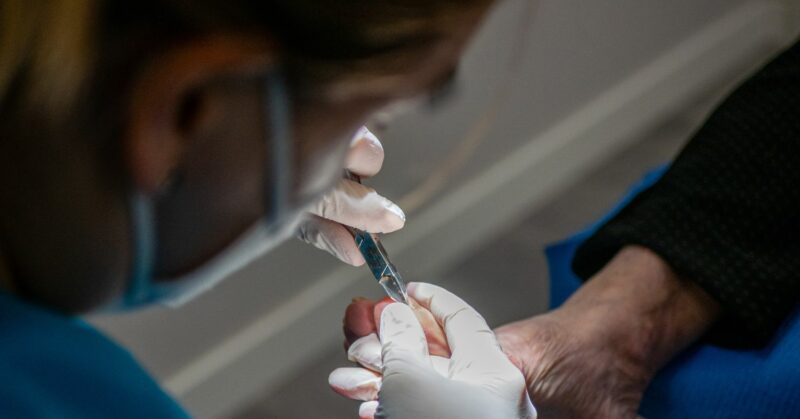With ingrown nails, the nail grows into the lateral nail bed. This causes painful inflammation of the nail wall and the surrounding skin. The big toe is most frequently affected. With our experience and medical-technical capabilities, we can help you achieve long-term success with ingrown nails.
What causes ingrown toenails and how can you protect yourself from them?
Ingrown toenails are caused by a disproportion between the width of the nail and the nail bed. As a result, the lateral part of the nail grows into the lateral nail edge (nail wall) and thus into the skin. Colonization with bacteria of the normal skin flora, as well as moisture and heat, leads to a purulent inflammation in the area of the lateral nail edge (unguis incarnatus, pronychia). This is also facilitated by heavy perspiration and incorrect nail cutting.
The big toe is usually affected because the nail is bordered on the sides by the nail wall and is exposed to the greatest pressure from the shoe. The pressure on the nail edge pushes the nail into the nail fold, where it grows into the sensitive skin and triggers an inflammation. The purulent inflammation also often causes sharp, shooting pains that make wearing shoes very painful. As the nail continues to grow, these complaints no longer disappear by themselves in the advanced stage and require medical clarification.
In some cases, relief can be achieved simply by cutting the nails correctly.

What are the possible triggers for ingrowth?
- When nails are cut too short and too round. A straight cut with clear corners can prevent ingrowth.
- Foot and nail deformities, such as pincer nails
- Moisture and heat build-up in the shoe
- Shoes that are too tight or too tight, because this causes strong pressure on the sides of the toes. This causes microtraumas and entry points for germs and bacteria.
Other risk factors that encourage a toenail to grow in:
- Overweight (obesity)
- Thick legs or water retention in the feet
- Venous diseases (chronic venous insufficiency)
- Heart failure (cardiac insufficiency)
- Diabetes mellitus
- Medication
- Malpositions of the foot
- Genetic predisposition
Surgical removal of ingrown nails with phenolization (cauterization) of the lateral nail root in Frankfurt
If the nail deformation is already too advanced or the inflammation is so severe that immediate action is required, the ingrown nail can also be surgically corrected. We do not remove the nail completely, but cut it out of the nail wall in a wedge shape and thus relieve the severely inflamed tissue.
To prevent the recurrence of an ingrowing nail, a so-called phenol matrix ablation is then performed. In this procedure, a rod soaked in phenol is rotated 3 x 1 min in the area of the nail root, chemically destroying the lateral root. This means that the nail can no longer grow back in the lateral area. This means that the nail can no longer grow into the lateral tissue and inflammation no longer occurs. Depending on the findings and surgical technique, the nail is sutured in or the wound is left open to heal.


